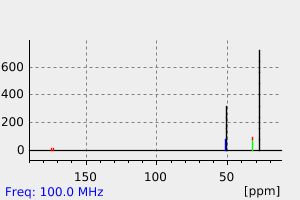dimethyl 2-(tert-butyl)succinate | 58219-46-8
中文名称
——
中文别名
——
英文名称
dimethyl 2-(tert-butyl)succinate
英文别名
Dimethyl t-butylsuccinate;dimethyl 2-tert-butylbutanedioate
CAS
58219-46-8
化学式
C10H18O4
mdl
——
分子量
202.251
InChiKey
SIQLTRFTIQODPF-UHFFFAOYSA-N
BEILSTEIN
——
EINECS
——
-
物化性质
-
计算性质
-
ADMET
-
安全信息
-
SDS
-
制备方法与用途
-
上下游信息
-
文献信息
-
表征谱图
-
同类化合物
-
相关功能分类
-
相关结构分类
物化性质
-
沸点:206.4±8.0 °C(Predicted)
-
密度:1.006±0.06 g/cm3(Predicted)
计算性质
-
辛醇/水分配系数(LogP):1.6
-
重原子数:14
-
可旋转键数:6
-
环数:0.0
-
sp3杂化的碳原子比例:0.8
-
拓扑面积:52.6
-
氢给体数:0
-
氢受体数:4
反应信息
-
作为产物:描述:3,3-dimethyl-1-butenyl-2-triflate 在 四甲基乙二胺 、 1,2-bis((tert-butyl(pyridin-2-yl)phosphanyl)methyl)benzene 、 palladium diacetate 、 对甲苯磺酸 作用下, 以 甲苯 为溶剂, 60.0~120.0 ℃ 、4.0 MPa 条件下, 反应 32.0h, 生成 dimethyl 2-(tert-butyl)succinate参考文献:名称:在温和条件下Pd催化乙烯基三氟甲磺酸酯羰基化为α,β-不饱和醛,酯和酰胺摘要:开发了一种有效的通用方案,可通过乙烯基三氟甲磺酸酯的羰基化反应合成α,β-不饱和醛,酯和酰胺,包括樟脑,酮异佛尔酮,马鞭草酮和普乐酮。这些转化的关键是使用含有吡啶基取代的d t bpx型配体的特定钯催化剂。该方法还使得容易从相应的酮获得二羰基化产物。DOI:10.1021/acs.orglett.9b00765
文献信息
-
Selective Palladium-Catalyzed Carbonylation of Alkynes: An Atom-Economic Synthesis of 1,4-Dicarboxylic Acid Diesters作者:Jiawang Liu、Kaiwu Dong、Robert Franke、Helfried Neumann、Ralf Jackstell、Matthias BellerDOI:10.1021/jacs.8b05852日期:2018.8.15dialkoxycarbonylation of various aromatic and aliphatic alkynes affording a wide range of 1,4-dicarboxylic acid diesters in high yields and selectivities. Kinetic studies suggest the generation of 1,4-dicarboxylic acid diesters via cascade hydroesterification of the corresponding alkynes. Based on these investigations, the chemo- and regioselectivities of alkyne carbonylations can be controlled as shown by switching
-
Hydrogen Atom Transfer Reactions via Photoredox Catalyzed Chlorine Atom Generation作者:Samantha Rohe、Avery O. Morris、Terry McCallum、Louis BarriaultDOI:10.1002/anie.201810187日期:2018.11.26waste‐limiting, and atom‐economical. The catalytic generation of chlorine atoms from chloride ions is one of the most challenging redox processes, where the requirement of harsh and oxidizing reaction conditions renders it seldom utilized in synthetic applications. We report the mild, controlled, and catalytic generation of chlorine atoms as a new opportunity for access to a wide variety of hydrogen atom transfer
-
Generation of Functionalized Alkyl Radicals via the Direct Photoexcitation of 2,2′-(Pyridine-2,6-diyl)diphenol-Based Borates作者:Yusuke Miyamoto、Yuto Sumida、Hirohisa OhmiyaDOI:10.1021/acs.orglett.1c01996日期:2021.8.6was developed for the purpose of generating radicals via direct photoexcitation. These borates were prepared using 2,2′-(pyridine-2,6-diyl)diphenol as a tridentate ligand together with organoboronic acids or potassium trifluoroborates. The ready availability of organoboron compounds is a significant advantage of this direct photoexcitation protocol. The excited states of these borates can also serve
-
Generation of Alkyl Radical through Direct Excitation of Boracene-Based Alkylborate作者:Yukiya Sato、Kei Nakamura、Yuto Sumida、Daisuke Hashizume、Takamitsu Hosoya、Hirohisa OhmiyaDOI:10.1021/jacs.0c04456日期:2020.6.3The generation of tertiary, secondary, and primary alkyl radicals has been achieved by the direct visible-light excita-tion of a boracene-based alkylborate. This system is based on the photophysical properties of the organoboron mole-cule. The protocol is applicable to decyanoalkylation, Giese addition, and nickel-catalyzed carbon-carbon bond for-mations such as alkyl-aryl cross-coupling or vicinal
-
Selective Aryl α-Diimine/Palladium-Catalyzed Bis-Alkoxy- carbonylation of Olefins for the Synthesis of Substituted Succinic Diesters作者:Francesco Fini、Michela Beltrani、Raffaella Mancuso、Bartolo Gabriele、Carla CarfagnaDOI:10.1002/adsc.201400501日期:2015.1.12palladium‐catalyzed oxidative bis‐alkoxycarbonylation reaction of olefins. The most active catalyst was formed in situ from bis(9‐anthryl)‐2,3‐dimethyl‐1,4‐diazabutadiene and palladium(II) trifluoroacetate [Pd(TFA)2]. This catalytic system was able to selectively convert olefins into succinic diesters in good yields (up to 97%) and low catalyst loading (up to 0.5 mol%) under mild reaction conditions [4 bar
表征谱图
-
氢谱1HNMR
-
质谱MS
-
碳谱13CNMR
-
红外IR
-
拉曼Raman
-
峰位数据
-
峰位匹配
-
表征信息
同类化合物
(±)17,18-二HETE
(±)-辛酰肉碱氯化物
(Z)-5-辛烯甲酯
(Z)-4-辛烯酸
(R)-甲羟戊酸锂盐
(R)-普鲁前列素,游离酸
(R,R)-半乳糖苷
(E)-4-庚烯酸
(E)-4-壬烯酸
(E)-4-十一烯酸
(9Z,12E)-十八烷二烯酸甲酯
(6E)-8-甲基--6-壬烯酸甲基酯-d3
(3R,6S)-rel-8-[2-(3-呋喃基)-1,3-二氧戊环-2-基]-3-羟基-2,6-二甲基-4-辛酮
龙胆二糖
黑曲霉二糖
黄质霉素
麦芽酮糖一水合物
麦芽糖醇
麦芽糖酸
麦芽糖基蔗糖
麦芽糖一水合物
麦芽糖
鳄梨油酸乙酯
鲸蜡醇蓖麻油酸酯
鲸蜡醇油酸酯
鲸蜡硬脂醇硬脂酸酯
鲸蜡烯酸脂
鲸蜡基花生醇
鲫鱼酸
鲁比前列素
鲁比前列素
高级烷基C16-18-醇
高甲羟戊酸
高效氯氰菊酯
高-gamma-亚油酸
马来酸烯丙酯
马来酸氢异丙酯
马来酸氢异丁酯
马来酸氢丙酯
马来酸氢1-[2-(2-羟基乙氧基)乙基]酯
马来酸单乙酯
马来酸单丁酯
马来酸二辛酯
马来酸二癸酯
马来酸二甲酯
马来酸二烯丙酯
马来酸二正丙酯
马来酸二戊基酯
马来酸二异壬酯
马来酸二异丙酯







